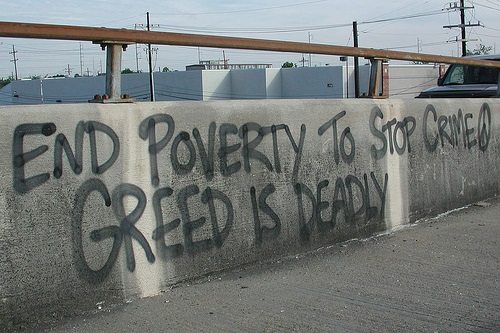
September 16, 2014; Washington Post
In its annual report on poverty, released yesterday, the U.S. Census Bureau writes that in 2013 the poverty rate dropped a half a percentage point, from 15 percent to 14.5 percent of the population. Furthermore, this past year is the first time that rate has dropped since 2006. The half a percentage point comprises approximately 1 million people, since the number of people in poverty in 2013 was 45.5 million. The report, however, says the reduction is not statistically significant.
Poverty among children declined from 21.8 percent to 19.9, but numbers were stagnant for those over 18. Finally, real median household income remained the same from 2012 to 2013 at about $52,000. This is eight percent, or $4,500, below what it was pre-recession. At the end of the 1990s, the median household income was $57,000 reckoned in today’s dollars.
Sign up for our free newsletters
Subscribe to NPQ's newsletters to have our top stories delivered directly to your inbox.
By signing up, you agree to our privacy policy and terms of use, and to receive messages from NPQ and our partners.
Poverty did fall significantly for Hispanics, suggesting significant gains among low-income Hispanic families with children. In fact, while poverty for families with kids declined by less than one percent for white non-Hispanic and African-American families, for Hispanic families with children, it fell 3.2 percent. Still, the Hispanic family poverty rate is 27 percent, against a 10 percent rate for white families. Black family poverty is at 32 percent.
The Washington Post concludes that “these are relatively minor improvements, and…the economic recovery has not done much to lift the living standards of most poor and middle-income households.” It points out that:
“The share of total household income held by the bottom fifth of households remained stuck at 3.2 percent last year, tied for the lowest level on record with data back to 1967. Similarly, the share of income accruing to the middle three-fifths of households (45.8 percent, up insignificantly from last year’s 45.7 percent) is close to its historic low.
“By definition, this implies near-record-high shares of income held by the best-off households. The top fifth held over half of all income last year (51 percent) with almost half of that share (22.2 percent) held by the richest 5 percent of households.”
The article points to what it describes as an increasing disconnect between economic growth and the economic wellbeing of most Americans, and calls policies that ignore the goal of shared prosperity complicit in the lack of recovery for most in the country.—Ruth McCambridge













